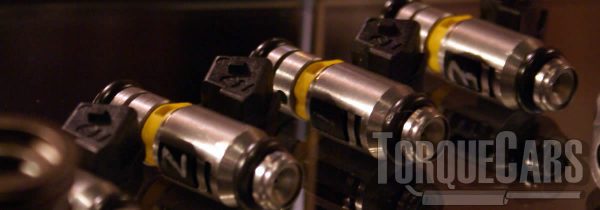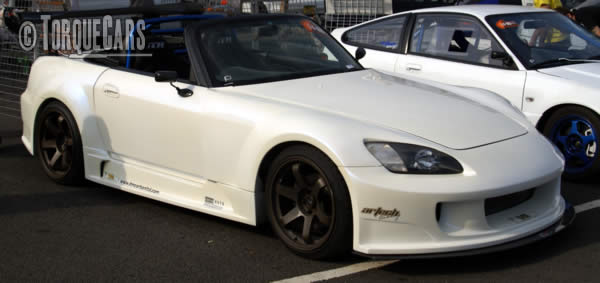Tuning the Honda F series
"Comprehensive guide to tuning the Honda F series engine!"
Let us look into F series tuning and report on the best mods that work. Honda F series are good project engines and with a few sensible modified parts like ECU maps, turbo upgrades and camshafts you will greatly increase your driving pleasure.
When talking about the best and most optimal modifications for your F series engine, we are going to focus on the tuning parts that give the best power gain for you spend.
Significant gains on the F series can be made from cam upgrades. Altering the cam profile alters the intake and exhaust durations on the engine and can dramatically change the bhp and power output.

NB: Fast road cams normally bump the bhp through the rpm range, you might lose a little low down bhp but the higher rpm power will improve.
Race cams, bump the higher rpm power band but as a result the car will not idle smoothly and low end power nearly always suffers.
On a typical daily driver you need to match your power band to your typical driving style.
I would be surprised if you have found a F series Competition camshaft is a pleasure to live with when driving in heavy traffic.

Each engine responds better to extreme camshaft durations than others.
The map and fuelling also have an effect on the torque gains you'll get.
Extending exhaust or intake durations can alter the torque band and on most engines the exhaust and intake durations do not need to match, although most cams and tuners use matched pairs there are some advantages to extending the intake or exhaust durations.
Stage 1 modifications: Sports exhaust manifold, Fast road camshaft, Drilled & smoothed airbox, Remaps/piggy back ECU, Panel air filters, Intake headers.
Stage 2 modifications: fuel pump upgrades, induction kit, Ported and polished head, Fast road cam, high flow fuel injectors, Sports catalyst & performance exhaust.
Stage 3 modifications: Twin charging conversions, Crank and Piston upgrades to alter compression, Engine balancing & blueprinting, Internal engine upgrades (head flowing porting/bigger valves), Competition cam, Adding or Upgrading forced induction (turbo/supercharger).
Remaps helps unlock the full potential of all the parts you've fitted to your F series.
It will usually give around 30% more power on turbocharged vehicles and you can expect to see around 15% on NASP engines, but the outcome often depend much on the parts you've done and the condition of your engine.
It is the main goal to any engine performance tuning job to feed more air into your F series
Intake flow the air during the suck phase from the filter and allow it to be drawn into the engine and mixed with fuel.
The bore size, shape and rate of flow of the Intake manifold can make a noticeable change to fuel atomisation and engine efficiency on the F series.
I usually find air intake manifolds are begging for motorsport parts, although some car makers provide reasonably good air intake manifolds.
Increasing the F series valve size, carrying out F series port enlargement and head flowing will also boost power, and as an added benefit will allow you to get a greater power increase on other upgrades.
Turbo upgrades

Structure and rate of flow of the Air Intake manifolds can make a large change to fuel atomisation and engine efficiency on the F Series.
On popular non F22C series production engines the plenum chambers are begging for a performance upgrade, although a few car makers provide well optimised plenum chambers.
Larger F18 F20 F22 Series valves, carrying out F Series port enlargement and head flowing will also improve power, and as an added benefit will allow you to get increasing the power increase on other parts.
The F Series block can handle quite a bit of power before it needs strengthening with people quoting power figures in excess of 350bhp.
NB: The S2000 F22C series of engines is one of the best OEM setups we've seen, and aftermarket parts such as flowing the head, revising the intake and exhaust modifications do not improve things very much at all.
F18 F20 F22 Series Turbo upgrades
The more air to get into an engine, the more fuel it can burn and uprating the induction with a turbocharger upgrade makes massive power gains.
Be careful adding boos because the 11:1 compression ratio will force you to run a pathetically low boost, unless you perform some extensive engine modifications to lower the compression ratio (you should ideally aim for around 9.5:1), and you may see power figures approaching 350bhp.
A build we saw recently that hit over 400bhp at the wheels included the following popular parts...
- NGK 7173s
- Garrett GT3582R
- ARP head studs
- Apex'i race blow off valve
- AEM 3.5 bar map sensor
- Precision 600 intercooler
- Walbro 255 fuel pump
- Siemens 875cc injectors
- Science of Speed 70mm throttle body
- InlinePro 3mm head gasket
If you change pistons you'll also need to change the sleeves.
NASP engines need quite a lot of work when you add a turbo, so we have a separate guide to help you take into account the pros and cons of going this route on your F series
The more air you can get into an engine, the more fuel it can burn and uprating the induction with a turbocharger upgrade makes superb power gains.
If your motor has a turbocharger mods are simpler to install and most turbo charged engines are built with many forged and stronger components.
However engines will have power limits
Discover these limits and install higher quality crank and pistons to survive the power.
We've seen mechanics spending a fortune on turbocharger upgrades on the F series only to experience the F series literally blow up on it's first outing after it's finished.
Big capacity turbo chargers tend to suffer a bottom end lag, and small turbo chargers spool up quickly but don't have the high rpm bhp gains.
Thanks to new tech the choice of turbo chargers is always improving and we commonly find variable vane turbo chargers, allowing the vane angle is altered according to speed to lower lag and increase top end bhp and torque.
Twin scroll turbo chargers divert the exhaust gases into two channels and feed these at differently angled vanes in the turbocharger. They also boost the scavenging effect of the engine.
You'll commonly see there's a restriction in the air flow sensor AFM/MAF on the F series when a lot more air is being drawn into the engine.
We see 4 bar air sensors coping with quite large power gains, whereas the OEM air sensor sapped performance at a much lower level.
Adding a supercharger or additional turbo will make large performance gains, although more complex to get working. We have this feature on twinchargers if you want to read more.
Fuelling upgrades and mods
You will need to ensure that the engine is not starved of fuel so will have to ramp up the fuelling when you start exceeding 20% of a performance increase. It makes sense to over specify your injectors flow rate.
It makes sense to over specify your injectors flow rate.
As a rule of thumb add 20% when buying an injector, which takes into account injector deterioration and provides a little spare capacity should the engine require more fuel.
We think this one is common sense, but you'll need to match your fuel injector to the type of fuel your car uses as well.
Exhaust upgrades and mods
You may need to boost your exhaust if your exhaust is actually causing a flow problem.
On most factory exhausts you'll find the exhaust flow rate is still good even on modest power gains, but when you start pushing up the power levels you will need to get a better flowing exhaust.
Sports exhausts increase the flow of gases through the engine.
But if your exhaust is too large, ie: it's over 2.5 inches bore, you will lose much of the flow rate and end up lacking power and torque.
Typically exhaust restrictions can be located the emissions filters installed, so adding a better flowing performance alternative will help avoid this restriction.
Weakspots and problem areas on the F18 F20 F22 Series
The F Series engines, if regularly serviced and maintained, are generally very reliable and have few issues.
Regular oil changes are vital on the F Series, particularly when the engine has been modified and is putting down more power than the manufacturer intended.
Watch the clutch, it's a know weakspot on tuned F series engines.
Test the compression ratio, worn engines can lose a lot of power.
History of the F Series Engine
The F series is a lovely engine, very free revving and incredibly well built and solidly tuned from the factory, especially the F20C versions fitted to the S2000.
The F20C shows what is possible on this F Series block with the right head and setup, showing the way for lower power versions.
The F20C made some great power figures from the factory
- Power: 240 bhp (179 kW) at 8,300 rpm
- Torque: 206 Nm (152 lbft) at 7,000 rpm
The F20C1 was further improved and the rod stroke length and camshaft profile was tweaked to lower the peak power point and raise torque.
- Power: 240 bhp (179 kW) at 7,800 rpm
- Torque: 220 Nm (162 lbft) at 7,000 rpm

- 1.8 L Honda F engine#F18B
- 94–02 (Accord) VTEC
F20
- 1988 2.0 L F20 (Accord) VTEC
- 92–97 F20A4 (Prelude) SOHC
- 00–05 F20C (S2000) (Japan)
- 00–03 F20C1 (S2000) (America)
F22
- 05–09 F22C (S2000) (Japan)
- 04–09 F22C1 (S2000) (America)
- 90–96 F22 (Accord/Prelude/CL/Odyssey/Isusu Oasis/Isuzu Aska) VTEC & Non-VTEC
- 98–02 2.3 L F23 (Accord/CL/Odyssey/Isuzu Oasis) VTEC
For more information on Tuning your Honda engine please join us in our friendly forum where you can discuss F Series tuning options in more detail with our F Series owners. It would also be worth reading our unbiased Honda tuning articles to get a full grasp of the benefits and drawbacks of each modification.
We need your help improving this article, so please send us your feedback in the comments box below and pass on any tips, points or facts we have wrong or have not covered.
We really like hearing from our readers, and hearing about which modifications were the most effective for them, it helps us improve our recommendations and articles to reflect current trends in modifications and ensures that our guides and tips are kept up to date.
Please Check out my YouTube channel, we're regularly adding new content...
PLEASE HELP: I NEED YOUR DONATIONS TO COVER THE COSTS OF RUNNING THIS SITE AND KEEP IT RUNNING. I do not charge you to access this website and it saves most TorqueCars readers $100's each year - but we are NON PROFIT and not even covering our costs. To keep us running PLEASE Donate here
If you liked this page please share it with your friends, drop a link to it in your favourite forum or use the bookmarking options to save it to your social media profile.
Feedback - What do You Think?
Please use our forums if you wish to ask a tuning question, and please note we do not sell parts or services, we are just an online magazine.
Help us improve, leave a suggestion or tip
Please watch this video and subscribe to my YouTube channel.

 Click to accept YouTube Cookies & Play.
Click to accept YouTube Cookies & Play.